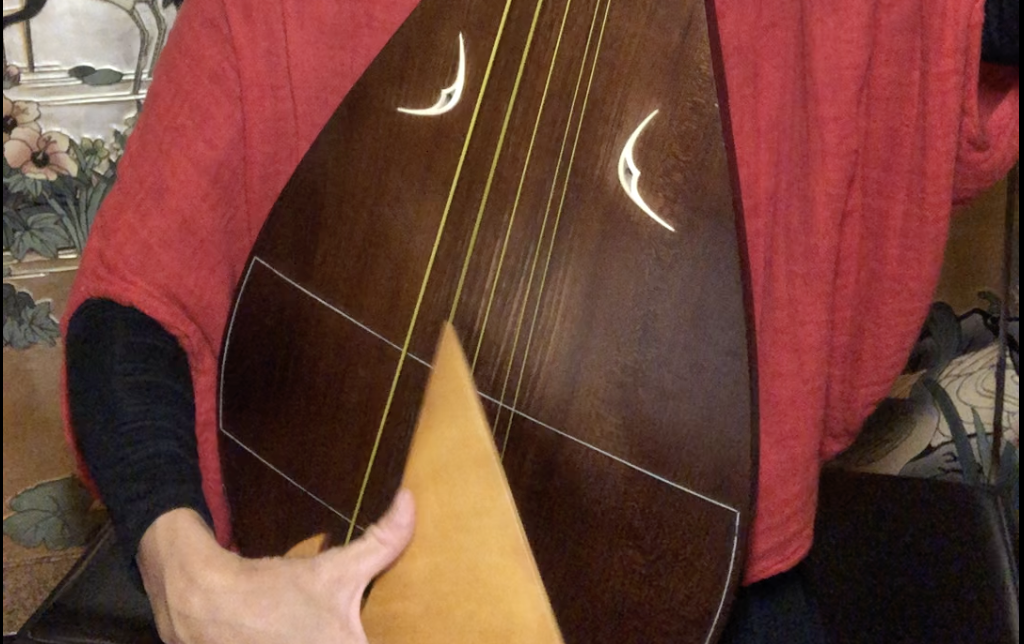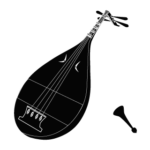About Biwa

Biwa is Japan’s traditional LONG-NECKED, 4 or 5-STRING PLUCKED
INSTRUMENT
After having arrived in Japan via the Silk Road for purely instrumental music, the biwa evolved over time into a narrative musical instrument. For a long time, the biwa tradition was carried on by wandering blind monks who used the instrument to tell stories such as the “Tale of Heike” (平家物語). Because of this tradition as a narrative music, the biwa is mostly played solo and is less commonly played with other types of instruments, except in “gagaku” (雅楽) or the court orchestra where it is used in its original instrumental role, and in modern instrumental repertoire.
History
The biwa originated in the Middle East and was delivered to Japan via the Silk Road in the 8th century. Upon its arrival, the biwa was used in purely instrumental music in the court culture – the instrument appears in various works of literature and art in the 10th -12th centuries, depicting nobles enjoying it in rituals as well as in their private lives. This type of biwa music has been preserved until now in “gagaku” (雅楽), or the court orchestra.
However, the biwa’s cultural significance is due to its evolution during the medieval era into a narrative musical instrument. The biwa, originally an instrument of high society, gradually spread among wandering blind monks who used this instrument to tell stories. In the 13th century, the story “The Tale of Heike” (平家物語)was created and told by them. This music was cherished and protected by the authorities and particularly flourished in the 14th-15th centuries. Telling stories and holding religious practices with biwa accompaniment became a profession for blind monks, and it was these wandering blind monks who carried on the tradition.
Modern biwa music is based on that medieval narrative biwa music. In the 18th century, samurai in the Satsuma area (southern part of Kyushu island) adopted the blind monks’ biwa music into their musical practices. Samurai ethics and battles were selected as the main themes for this style, called Satsuma-biwa (薩摩琵琶), and more dynamic techniques were developed. Another new style called Chikuzen-biwa (筑前琵琶) was created in the 19th century in northern Kyushu Island, based off of the blind monks’ biwa music, and adopting shamisen, Satsuma-biwa, and other contemporary musical styles. These two modern styles came to Tokyo with the local reformists who led the Meiji Restoration, and became the center of the contemporary music scene in the late 19th to early 20th century.
During the war time in early 20th century, biwa music was easily adapted to the nationalism of Imperial Japan, and many songs that emphasized the virtue of loyalty and sacrifice for the country were created and widely played. With the end of the wars, unsurprisingly, the biwa music became less popular, and the number of biwa musicians dropped significantly. It was in the late 20th century that this instrument started to be re-discovered and re-evaluated in various musical settings, such as soundtrack for movies and ensemble and orchestra music, culminating in Toru Takemitsu’s signature piece “November Steps,” which premiered in New York City in 1967. Today, the instrument is played in both narrative and instrumental formats, in the traditional music scene as well as in various popular media.
Written by Nobuko Fukatsu
https://japanese-music.com/profile/nobuko-fukatsu/
Instrument
- Construction
The biwa is a relative of Western lutes and guitars, as well as of the Chinese pipa. It is made out of wood, with a teardrop-shaped body and a long neck with four or five high frets, and is stringed with four or five silk strings that are plucked by a big pick called “bachi” (撥). The peg box is angled about 90 degrees from the neck, and the back of the body is flat, unlike the western lute.
The number of frets is considerably fewer than other fretted instruments. This seeming shortcoming is compensated for by the frets’ height and the low tension of the strings. In all biwa styles, except for Gaku-biwa (楽琵琶: please refer to the section “Types of Biwa”), fingers are positioned between the frets, not on the frets. And thanks to the low tension of the strings, it is easy to bend the strings by adding pressure. Because of this bending technique “oshikan” (押シカン), one can make two or three notes for each fret and also in-between notes.
Further, the frets and the nut are wide, which provides a surface, not a point, for a string to touch. This causes a sustained, buzzing noise called “sawari” (サワリ) which adds a unique flavor to the biwa sound. The surface of the frets is constantly shaved down by the strings, and one of the most important points in the maintenance of the biwa is to keep the surfaces as flat as possible to get good “sawari”.
- Tuning
The narrative biwa music adopts a relative tuning; the pitch is decided to match with the player’s range of voice. In Satsuma-biwa classical pieces, the thickest string (the first) is in principle used only as a drone, and usually tuned to the same note as the third string, making the second the lowest. The fourth and fifth strings, if 5-stringed, are tuned to the same note. The typical 5-stringed Satsuma-biwa classical tuning is: CGCG, from first string to fourth/fifth string, respectively. The fourth/fifth string G is an octave higher than the second string G. Again, note this is relative tuning; it could be AEAE, GDGD, etc, depending on the player’s range of voice.
- Technique
The biwa strings are plucked with large wooden pick called bachi (撥) that requires a full-handed grip. The basic technique is to pluck down and up with the sharp corner. Multiple strings are often played in one pluck like an arpeggio. In modern biwa, particularly in Satsuma-biwa, one sometimes strikes the soundboard sharply to get percussive effects. Another often-used technique is rubbing the long side of the “bachi” on the strings to get wind-like sounds.
For the left hand, as mentioned above under the “Construction” section, bending of the strings (“oshikan” 押シカン) and delicate control of it to create a vibrato effect (“yuri” ユリ) are crucial techniques to create the biwa’s subtle in-between notes that are unique for fretted instruments.
Written by Nobuko Fukatsu
https://japanese-music.com/profile/nobuko-fukatsu/
Types of Biwa
The biwa developed into five different types in its long history: Gaku, Heike, Mōsō, Satsuma, and Chikuzen. Each type has different and unique tones, techniques, and musical styles.
- Gaku-biwa (楽琵琶)
This is the original form of biwa that came to Japan in the 8th century. This type of biwa is used for court music called “gagaku” (雅楽), which has been protected by the government until today. It has the largest body and relatively short neck among biwas. A player holds it horizontally, and mostly plays rhythmic arpeggios in orchestra or ensemble.
- Heike-biwa (平家琵琶)
Heike-biwa is an accompaniment instrument specifically used to chant the “Tale of Heike” stories (平家物語) in the traditional way dating from the medieval era. This music called “heikyoku” (平曲) was cherished and protected by the authorities and particularly flourished in the 14-15th centuries. The main part of the music is vocal and the biwa part mostly plays short interludes. The instrument itself resembles gaku-biwa but is slightly smaller, and is held horizontally.
- Mōsō-biwa (盲僧琵琶)
This is a type of biwa that wandering blind monks played for religious practice as well as in narrative musical performances during the medieval era, widely seen in the Kyushu area. The body is narrower and smaller than the other types of biwa. It was those blind monks who fell outside of governmental protection who, during the 17th century, creatively modified the biwa to introduce a shamisen flavor, such as making frets higher to play in-between notes.
- Satsuma-biwa (薩摩琵琶)
As one of the modern types of biwa that flourished in the late 19th to early 20th centuries, Satsuma-biwa is widely played today in various settings, including popular media. Reflecting its history as an instrument for samurai, its music is often described as dynamic and heroic. The traditional Satsuma-biwa has 4 strings and 4 frets (Sei-ha 正派and Kinshin-ryu 錦心流schools), and newer styles have 5 strings and 5 frets (Nishiki 錦 and Tsuruta-ryu 鶴田流 schools). Its pick or “bachi” (撥) is the largest among all types of biwa – it sometimes used to strike the hard soundboard sharply to create percussive effects, adding a more dynamic flavor to the music. Players hold the instrument vertically.
- Chikuzen-biwa (筑前琵琶)
Chikuzen-biwa is another major type of biwa that is widely played today. Influenced by the shamisen, its music is rather soft, attracting more female players. As in shamisen music, vocal and instrumental parts are sometimes combined and played at the same time. There are 4-string and 5-string biwas, both with 5 frets, and the soundboard is made from soft paulownia wood. The instrument is also held vertically while playing.
Written by Nobuko Fukatsu
https://japanese-music.com/profile/nobuko-fukatsu/
Resources
Discover additional information about the Shamisen below


